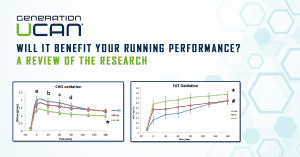Last time, we got an introduction to fueling issues in the marathon and reviewed a neat study on how you can predict whether or not you’ll “hit the wall” by running out of carbohydrates in your next marathon.
Today, we’re turning our attention to how to avoid the wall by refueling our carbohydrate reserves while we’re running.
The basic premise is simple: we want to consume enough fuel, in the form of carbohydrates, to get ourselves across the finish line without running out of energy. But there are a lot of smaller questions that need answering, too:
What kind of carbohydrate is best?
How should you parse out your fueling?
How far into the race should you start refueling?
Fortunately, scientific research has developed a pretty simple 3-step formula to prevent you from hitting the wall: (1) determine what type of carbohydrate is best; (2) examine your ability to absorb and use glycogen while running; and (3) calculate exactly how many calories you’ll need to take in before you run out of energy.
Let’s take a look at each step in depth:
The best energy source for running a marathon
Over time, scientists have determined that the best types of fuel for topping off your energy reserves while running are simple forms of sugar like sucrose, glucose, and fructose—they’re easy to ingest, quick to be absorbed, and readily broken down into fuel.
In fact, the best form of fuel appears to be a mix of glucose and fructose, which is readily available in any number of commercial sports drinks.
High fructose corn syrup has gotten a bad rap recently (and Gatorade even abandoned it as an ingredient), but the reasons why it’s unhealthy for sedentary people are the same reasons why it’s great during a marathon: fructose and glucose are quickly shuttled from your digestive system into your bloodstream, and can be processed “in parallel,” meaning you can absorb and use 100 calories of a mixture of glucose and fructose faster than you can absorb and use 100 calories of either sugar individually.
To further support this claim, I’ll include research from an earlier article we published on sugar/CHO absorption and marathon training.
Early research on sports drinks concluded that the maximum amount of a single form of carbohydrate that could be absorbed during exercise was about 1 gram per minute. Once the glucose transporters are saturated, the body cannot absorb any additional sugar in the form of glucose no matter how much is given.
Recent research has since shown that the body can increase CHO absorption to 1.5 grams of glucose per minute when multiple carbohydrate forms are combined.
This is because the different sugars use different transport mechanisms to pass through the intestinal wall. Fructose uses a different intestinal transporter so the body can continue to absorb sugars via that mechanism after the glucose transporters are saturated. The result is more carbohydrate being available as fuel and less sitting in the stomach and potentially causing cramping or other GI problems.
The research on absorption and sugar combinations
Dr. Jeukendrup at the University of Birmingham School of Sport and Exercise Sciences has conducted a great deal of research on sports drinks and carbohydrate absorption and oxidation rates.
In 2008, eight trained male cyclists participated in a randomized crossover study in which they consumed either water, a glucose-only beverage, or a 2:1 ratio glucose and fructose beverage.
The beverages were ingested before exercise, at 15 minute intervals during two hours of steady state cycling, and at three separate intervals during a time trial immediately following the steady state ride.
Results showed that ingesting a 2:1 ratio glucose and fructose beverage improved time performance by 8 percent compared with just glucose and an 18 percent improvement compared with just water.
Results from cycling studies of this nature can generally be applied to running as well, since in later studies when measured during both cycling and running at a moderate intensity, absorption rates were similar. (Pfeiffer et al. 2011).
Researchers concluded that a mixed carbohydrate beverage that includes fructose, increases absorption and subsequent oxidation of carbohydrate.
Jeukendrup has researched additional sugar combinations that include fructose (glucose + fructose, maltodextrin + fructose, and a mixture of glucose, fructose, and sucrose) and has seen similar absorption and oxidation rates.
What type of fuel is best – liquid, gels or solid?
Though there is a huge variety of brands and forms of carbohydrates to refuel with, a 2011 review article by Louise Burke and fellow researchers in Australia, China, and the UK concluded that gels (GU), solids (“energy blocks”), and liquids (Gatorade, Powerade) are all equally good at providing energy.
Whichever you choose to use is largely a matter of personal preference—some runners prefer the compact form of gels or energy blocks, but they can also cause gastrointestinal cramping, so you’ll have to try them out before you use them in races.
How fast can your body absorb these energy sources?
That being said, all sources of carbohydrates in the marathon are limited by the same thing: how fast your body can actually absorb the energy and start to use it.
Even though simple sugars like glucose and fructose get fast-tracked for absorption, the rate at which you can absorb them is still the bottleneck when it comes to marathon fueling.
Absorption rates and maximum caloric intake
As previously discussed, most research demonstrates that the rate of absorption is around 1 gram of carbohydrates per minute, with a few studies reporting values of up to 1.5 grams per minute with glucose-fructose mixtures.
This means it doesn’t make much sense for most people to consume more than 60g of carbohydrates per hour during a marathon, which conveniently translates to about one liter (34 oz) of most standard-mixed sports drinks per hour. For reference, a normal paper cup at an aid station holds about five ounces.
If you do a little math, you can see that your maximum caloric intake is only going to be about 246 calories of carbohydrates per hour.
At best, this is enough to fuel about three miles of running for a typical marathoner. That’s not nearly enough energy intake to support your energy expenditure during the marathon if you wait until you’ve almost run out of energy. So this is one reason why you need to start refueling far before you actually run out of energy.
Another reason is that your body appears to dial back your ability to run fast well before your carbohydrate fuel tank is actually empty, probably in an effort to slow down how quickly it’s losing carbs.
A 2008 paper by John Bennett and Michael Kehoe at the University of Central Florida cites research showing that performance is impeded when carbohydrate reserves dip below 30-50%, and they encourage beginning to refuel at least 30min before this point.
How much energy will you need to finish the marathon
Using the model we developed in the previous article, we can do some quick math on how much energy you’ll actually need. In a reasonable estimate, a marathoner might expect to “hit the wall” (i.e. run out of carbs) at 20 miles into the race.
To prevent this, we need to consume enough energy for a bit over six miles of running. We’ll need one more number to figure out our fueling plan: the actual cost of running, in calories per mile.
A computational model described in a 2010 paper by Benjamin Rapoport cites a cost of 0.73 calories per pound per mile, meaning that the speed you run at isn’t a factor, but your weight is. So, a 150-pound runner burns 110 calories to run one mile.
But let’s not forget that only some of these calories need to be from carbs; your body can make up the rest by burning fat.
Rapoport’s model also predicts that, for most marathoners, no more than 75% of your energy will come from carbs. So we can reduce our energy cost down to 83 carbohydrate calories per mile. Over 6.2 miles, that’s 515 calories.
Keeping in mind the limit of absorption, we’d need two hours (and five minutes) to take in this much energy while running.
Now, all of these numbers are pretty conservative, and they aren’t going to be exact. But there are some concrete lessons and insights to take away from the above info, independent of all the math.
- First, you should start refueling fairly early into the marathon—perhaps after about 45 minutes of running
- Second, you can jump-start your refueling by taking in some carbs 10 or 15 minutes before the race, as this will allow you some “free” carb absorption time while running.
- Finally, since the energy cost to cover a certain distance is a function of your weight, heavier runners are going to have a tougher time getting enough fuel in during their race to avoid hitting the wall.
- Let’s also not forget that taking in too much sugar, especially at one time, can be just as detrimental as not having enough. We know your body can only process 1 gram of carbohydrate per minute. If you ingest significantly more than this, you’re very likely to get sick, cramp, or throw up.
How you can avoid ‘hitting the wall’
- Ultimately, you’ll have to experiment with what type of fueling strategy works best for you. This is why practicing your marathon fueling strategy is essential. Here is a step-by-step guide for how to practice your marathon nutrition strategy.
- If you’ve had issues with hitting the wall, you should aim for 60 or perhaps even 90 grams (246-369 calories) of carbohydrates per hour while you run.
- You can try sports drinks like Gatorade or Powerade, gel energy shots, or solid carbs like energy cubes—each has advantages and disadvantages, but they are all valid choices for fueling. There is no “secret” food. You need to find what works best for your stomach
- Start fueling early and fuel often. It’s a lot easier to sip a few ounces of a sports drink every few miles than it is to chug twenty or thirty ounces once an hour.
Taking some time before your race to plan out your fueling strategy can pay big dividends if it allows you to cruise right through the wall and on to a marathon PR.





4 Responses
Problems with the link Free ebook marathom nutrition who can help me
Great article. I’m going to try bumping up my intake from 30 cal/mi to 50 cal/mi (figuring a little better than 6 mi/hr) to see if I can push my wall back. Besides concluding that I need MORE calories while running, I now understand that I will absorb them better (in parallel) with a mixture of fructose & glucose. So I looked at the ingredients of what I’m using (Clif Gel in my case) to try to determine if that’s what it has or if I should mix up products. What I found was: Organic Maltodextrin, Organic Dried Cane Syrup. Is that glucose, fructose, sucrose, all of the above, some of the above, none of the above? I don’t know.
Any tips on how ingredients on product labels map to the various types of sugars I should be taking in?
Great read, very insightful. Like Kyle, I’m struggling with what to use, as the sugar composition is not listed in the ingredients of my Cliff Blocks. I also can’t find the sugar composition while experimenting with natural foods, such as dates and raisins, only the amount of carbs/fiber. Do you (or anyone out there) know where you can find such info? I may know I’m getting 40g of carbs every 30 minutes, but have no idea what the actual sugar breakdown is, making it difficult to determine if my fuel strategy could be more efficient.
As for drinks, I have 100% glucose (dextrose). Do you recommend buying 100% fructose to mix in a 2:1 glucose:fructose ratio with water and perhaps a dash of sea salt? Has anyone tried anything this with any success? This sounds more efficient than the normal sports drink, it would be a matter of strategically placing family/friends during races or learning how to carry my own fuel, as I’ve avoided the belts. Any ideas or suggestions are welcome
Where is this math coming from?
“If you do a little math, you can see that your maximum caloric intake is only going to be about 246 calories of carbohydrates per hour.”